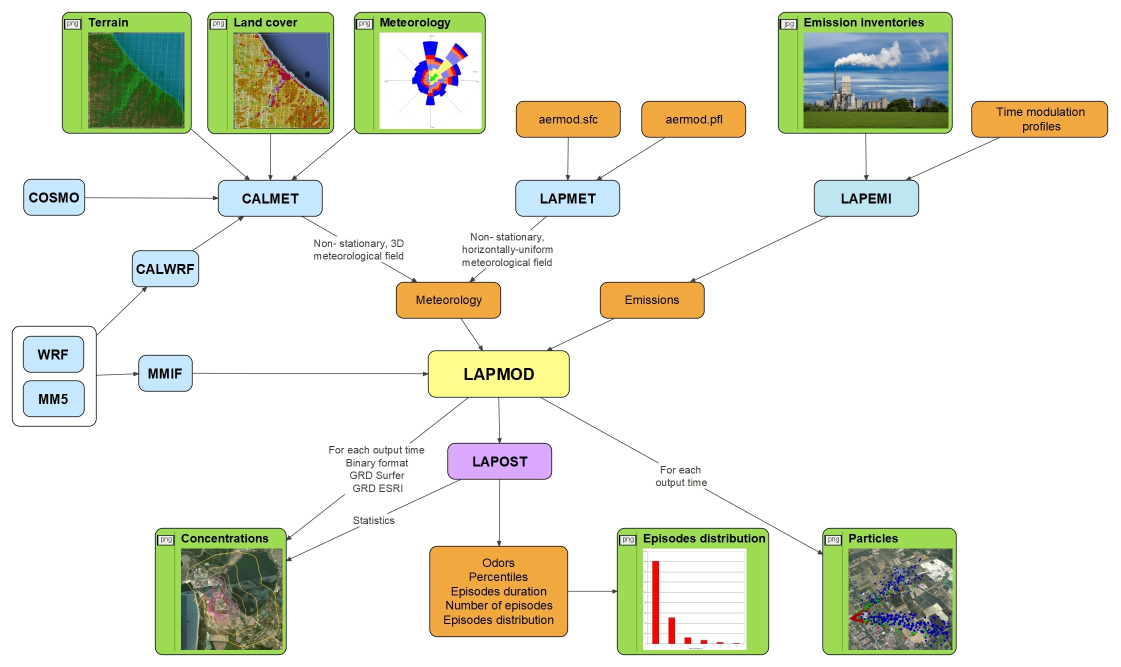The LAPMOD system
A Lagrangian particle modeling system for simulating the atmospheric dispersion and removal of inert gaseous or aerosol species.LAPMOD, the core of the LAPMOD modeling system, is a tridimensional non-stationary Lagrangian particle model that can be used to simulate the atmospheric dispersion over complex terrain of gases and aerosols, inert or radioactive. LAPMOD can also simulate the dispersion of odors.
Latest papers about LAPMOD:
- Bellasio R., Bianconi R. and Zannetti P. (2025) A Comparison of CALPUFF and LAPMOD Against the Project Sagebrush Datasets. Atmosphere, 16(6), 671.
- Bellasio R. and Bianconi R. (2025) Analysis of the Odor Levels at the Closest Receptors Depending on the Stack Terminal Types. Atmosphere, 16(2), 169.
- Bellasio R. and Bianconi R. (2022) A Heuristic Method for Modeling Odor Emissions from Open Roof Rectangular Tanks. Atmosphere, 13(3), 367, 2022.
- Bellasio R., R. Bianconi, S. Mosca and P. Zannetti (2018) Incorporation of Numerical Plume Rise Algorithms in the Lagrangian Particle Model LAPMOD and Validation against the Indianapolis and Kincaid Datasets Atmosphere 2018, 9(10), 404; doi:10.3390/atmos9100404 (Open Access Paper)
- Bellasio R., R. Bianconi, S. Mosca and P. Zannetti (2017) Formulation of the Lagrangian particle model LAPMOD and its evaluation against Kincaid SF6 and SO2 datasets Atmospheric Environment, Vol. 163, pp. 87-98. doi:10.1016/j.atmosenv.2017.05.039
Download LAPMOD (version 20250611)
For a quick start, there are also some test cases available here.
The particles used for the calculation are moved in the atmosphere by the average wind and turbulence. Each particle carries a fraction of the emitted mass of pollutant. At each time step it is possible to calculate the concentration and the deposition at selecred receptors by considering the position of the particles and their masses.
LAPMOD is fully coupled with the diagnostic meteorological model CALMET that provides all the necessary information about wind speed and direction as well as about turbulence parameters. CALMET can be interfaced with the prognostic meteorological model WRF.
LAPMOD is a complete modeling system, since it has a meteorological preprocessor, LAPMET, that allows to use as meteorological input also the US-EPA AERMOD meteorological input files (surface and profile). Moreover, the output files produced by LAPMOD can be elaborated by the postprocessor LAPOST to calculate the statistics of interest and most of the FIDOL parameters (i.e. frequency, intensity, duration and location) in case of odors.
LAPMOD simulates the release with arbitrarily variable rate from a number of source types:
- buoyant and non-buoyant point sources
- linear sources
- circular sources
- volumetric sources (parallelepipeds and spheres)
- area sources of arbitrary shape
LAPMOD calculates average (on user-defined periods) and integrated concentration, as well as dry and wet deposition fields. In case of radioactive releases, these fields can be used for calculating the doses (cloudshine, groundshine and dose due to inhalation).
Particles can be tracked to study the atmospheric flow.
LAPMOD has been validated against the data of the Kincaid experiment, both with the short-term SF6 and the long-term SO2 releases.
The following scheme shows the the structure of the LAPMOD modeling system.
The theory behind the model is fully described here.
